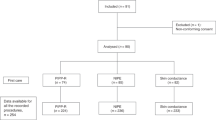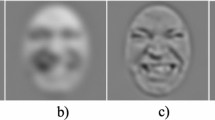Abstract
Objective
To verify the visual attention of adults when assessing neonatal pain.
Study design
143 adults (59% health professionals) evaluated 20 pictures (2 pictures of 10 neonates’ faces: at rest; during a painful procedure). Tobii-TX300 tracked the participants’ eyes movement. For each picture, adults scored pain intensity (0 = no pain; 10 = maximum). Latent classes analysis was applied by cognitive diagnosis models—GDINA with two attributes (knowledge of pain presence/absence). Variables associated with belonging to the class of adults that correctly identified pictures of newborns with/without pain were identified by logistic regression.
Results
To identify neonatal pain, adults look at the mouth, eyes, and forehead in facial pictures. The latent class analysis identified four classes of adults: those that identify painful/painless neonates (YY-Class; n = 80); only painful neonates (n = 28); only painless neonates (n = 34) and none (n = 1). Being a health professional (OR: 2.29; 95% CI: 1.16–4.51), and each look at the nasolabial furrow (2.07; 1.19–3.62) increased the chance of belonging to the YY-class.
Conclusions
Being a health professional and the visual fixation at the nasolabial furrow helped to identify the presence/absence of neonatal pain.
This is a preview of subscription content, access via your institution
Access options
Subscribe to this journal
Receive 12 print issues and online access
$259.00 per year
only $21.58 per issue
Buy this article
- Purchase on Springer Link
- Instant access to full article PDF
Prices may be subject to local taxes which are calculated during checkout

Similar content being viewed by others
References
Hadjistavropoulos T, Craig KD, Duck S, Cano A, Goubert L, Jackson P, et al. A biopsychosocial formulation of pain communication. Psychol Bull. 2011;137:910–39. https://doi.org/10.1037/a0023876
Anand KJS, EUROPAIN survey working group of the Neo Opioid Consortium. Assessment of continuous pain in newborns admitted to NICUs in 18 European countries. Acta Paediatr. 2017;106:1248–59. https://doi.org/10.1111/apa.13810
Olsson E, Ahl H, Bengtsson K, Vejayaram DN, Norman E, Bruschettini M, et al. The use and reporting of neonatal pain scales: a systematic review of randomized trials. Pain. 2021;162:353–60. https://doi.org/10.1097/j.pain.0000000000002046
Boyle EM. Measuring and managing pain in the fetus and neonate—a new era and new challenges. Semin Fetal Neonatal Med. 2019;24:101018 https://doi.org/10.1016/j.siny.2019.101018
Eriksson M, Campbell-Yeo M. Assessment of pain in newborn infants. Semin Fetal Neonatal Med. 2019;24:101003 https://doi.org/10.1016/j.siny.2019.04.003
Bruck R, Miller R. Sex, personality, and physiological variables in the communication off affect via facial expression. J Pers Soc Psychol. 1974;30:S87–S96. https://doi.org/10.1037/h0037041
Elias LS, Guinsburg R, Peres CA, Balda RC, Santos AM. Disagreement between parents and health professionals regarding pain intensity in critically ill neonates. J Pediatr. 2008;84:35–40. https://doi.org/10.2223/JPED.1748
Pillai Riddell RR, Horton RE, Hillgrove J, Craig KD. Understanding caregiver judgments of infant pain: contrasts of parents, nurses and pediatricians. Pain Res Manag. 2008;13:489–96. https://doi.org/10.1155/2008/694745
Pillai Riddell R, Flora DB, Stevens S, Greenberg S, Garfield H. The role of infant pain behavior in predicting parent pain ratings. Pain Res Manag. 2014;19:e124–32. https://doi.org/10.1155/2014/934831
Priebe JA, Messingschlager M, Lautenbacher S. Gaze behavior when monitoring pain faces: an eye-tracking study. Eur J Pain. 2015;19:817–25. https://doi.org/10.1002/ejp.608
Vervoort T, Trost Z, Prkachin KM, Mueller SC. Attentional processing of other’s facial display of pain: an eye tracking study. Pain. 2013;154:836–44. https://doi.org/10.1016/j.pain.2013.02.017
Heiderich TM, Leslie AT, Guinsburg R. Neonatal procedural pain can be assessed by computer software that has good sensitivity and specificity to detect facial movements. Acta Paediatr. 2015;104:e63–9. https://doi.org/10.1111/apa.12861
Grunau RE, Oberlander T, Holsti L, Whitfield MF. Bedside application of the Neonatal Facial Coding System in pain assessment of premature neonates. Pain. 1998;76:277–86. https://doi.org/10.1016/s0304-3959(98)00046-3
Grunau RV, Craig KD. Pain expression in neonates: facial action and cry. Pain. 1987;28:395–410. https://doi.org/10.1016/0304-3959(87)90073-x
van Dijk M, Koot HM, Saad HHA, TibboeL D, Passchier J. Observational visual analog scale in pediatric pain assessment: useful tool or good riddance? Clin J Pain. 2002;18:310–6. https://doi.org/10.1097/00002508-200209000-00006
Berde CB, Lehn BM, Yee JD, Sethna NF, Russo D. Patient-controlled analgesia in children and adolescents: a randomized, prospective comparison with intramuscular administration of morphine for postoperative analgesia. J Pediatr. 1991;118:460–6. https://doi.org/10.1016/s0022-3476(05)82169-9
Bray RJ, Woodhams AM, Vallis CJ, KellY PJ, Ward-Platt MP. A double-blind comparison of morphine infusion and patient-controlled analgesia in children. Paediatr Anaesth. 1996;6:121–7. https://doi.org/10.1111/j.1460-9592.1996.tb00374.x.
Dijk van M, Boer de JB, Koot HM, Tibboel D, Passchier J, Duivenvoorden HJ. The reliability, stability and validity of the COMFORT scale as a postoperative pain instrument in 0 to 3-year-old infants. Pain. 2000;84:367–77. https://doi.org/10.1016/s0304-3959(99)00239-0
Ma W de la TorreJ. GDINA: the generalized DINA model framework. R package version 2.7.9. 2020. https://CRAN.R-project.org/package=GDINA.
Williams AC. Facial expression of pain: an evolutionary account. Behav Brain Sci. 2002;25:439–88. https://doi.org/10.1017/s0140525x02000080
Schiavenato M, Butler-O’Hara M, Scovanner P. Exploring the association between pain intensity and facial display in term newborns. Pain Res Manag. 2011;16:10–12. https://doi.org/10.1155/2011/873103.
Grunau RV, Johnston CC, Craig KD. Neonatal facial and cry responses to invasive and non-invasive procedures. Pain 1990;42:295–305. https://doi.org/10.1016/0304-3959(90)91142-6.
Eisenbarth H, Alpers GW. Happy mouth and sad eyes: scanning emotional facial expressions. Emotion. 2011;11:860–5. https://doi.org/10.1037/a0022758.
Guo K. Holistic gaze strategy to categorize facial expression of varying intensities. PLoS ONE. 2012;7:e42585 https://doi.org/10.1371/journal.pone.0042585.
Schurgin MW, Nelson J, Iida S, Ohira H, Chiao JY, Franconeri SL. Eye movements during emotion recognition in faces. J Vis. 2014;14:1–16. https://doi.org/10.1167/14.13.14.
Stevens B, McGrath P, Dupuis A, Gibbins S, Beyene J, Breau L, et al. Indicators of pain in neonates at risk for neurological impairment. J Adv Nurs. 2009;65:285–96. https://doi.org/10.1111/j.1365-2648.2008.04854.x.
Craig KD, Korol CT, Pillai RR. Challenges of judging pain in vulnerable infants. Clin Perinatol. 2002;29:445–57. https://doi.org/10.1016/s0095-5108(02)00022-2
Melloni M, Lopez V, Ibanez A. Empathy and contextual social cognition. Cogn Affect Behav Neurosci. 2014;14:407–25. https://doi.org/10.3758/s13415-013-0205-3
Cheng Y, Chen C, Decety J. How situational context impacts empathic responses and brain activation patterns. Front Behav Neurosci. 2017;11:165. https://doi.org/10.3389/fnbeh.2017.00165
ABEP. Associação Brasileira de empresas de Pesquisa. Critério padrão de classificação econômica do Brasil. São Paulo, 2015. http://www.abep.org/criterio-brasil. Accessed 3 Nov 2020.
Acknowledgements
We thank Fundação de Amparo à Pesquisa de São Paulo (FAPESP) and Coordenação de Aperfeiçoamento de Pessoal de Nível Superior (CAPES) for the financial support. Fundação de Amparo à Pesquisa do Estado de São Paulo—Fapesp—Grant Nos. 2012/50157-0 and 2018/13076-9. The funder did not participate in the work.
Author information
Authors and Affiliations
Contributions
MCMB, CET, and RG: responsible for conception and design of the study, data analysis and interpretation, and writing the manuscript. GVTS, JCAS, TMH, and RCXB: responsible for study design, patient screening and enrollment, data collection, data analysis and interpretation, and for revising the manuscript. LPC, RNO, and PASOS: responsible for study design, data collection, data analysis and interpretation, and for revising the manuscript. AS and SO: responsible for the statistical data analysis and writing the manuscript.
Corresponding author
Ethics declarations
Competing interests
The authors declare no competing interests.
Additional information
Publisher’s note Springer Nature remains neutral with regard to jurisdictional claims in published maps and institutional affiliations.
Rights and permissions
About this article
Cite this article
Barros, M.C.d.M., Thomaz, C.E., da Silva, G.V.T. et al. Identification of pain in neonates: the adults’ visual perception of neonatal facial features. J Perinatol 41, 2304–2308 (2021). https://doi.org/10.1038/s41372-021-01143-1
Received:
Revised:
Accepted:
Published:
Issue Date:
DOI: https://doi.org/10.1038/s41372-021-01143-1



